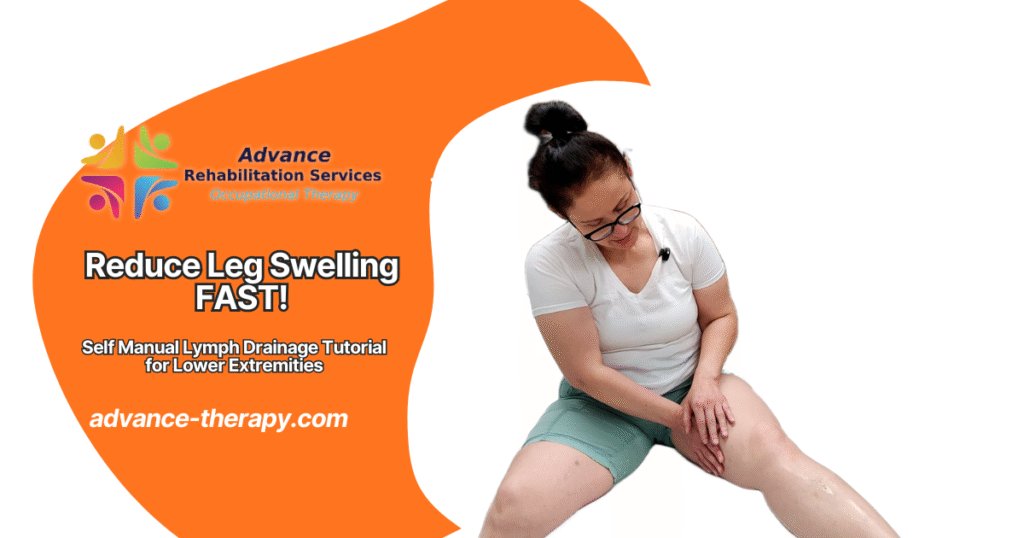If you’re experiencing swelling, heaviness, or discomfort in your legs or feet due to lymphedema or post-surgical fluid buildup, self manual lymph drainage (MLD) can be a gentle, effective way to promote fluid movement and reduce symptoms from the comfort of home. At Advanced Rehabilitation Services in Morris County, Parsippany, New Jersey, our board-certified occupational therapists specialize in lymphedema management and empower patients with safe, practical techniques like this one. Below is a complete, easy-to-follow guide based on proven methods—perfect for beginners or anyone looking to maintain progress between therapy sessions.
Note: Always consult your healthcare provider before starting self-MLD, especially if you have open wounds, active infection, blood clots, or heart/kidney issues. This technique is not a substitute for professional care.
What You’ll Need
- A moisturizer of your choice (castor oil, lotion, or cream—castor oil is a favorite for its glide and skin benefits)
- A quiet, comfortable space where you can lie down
- Optional: pillows for leg support
Step-by-Step Self Manual Lymph Drainage for Lower Extremities
1. Prepare Your Skin
Apply a small amount of moisturizer to the affected leg(s) and foot. This keeps skin supple and ensures smooth skin-on-skin contact—essential for effective fluid movement.
2. Open the Central Lymphatic Pathways
Always start “upstream” so fluid has somewhere to go.
Clavicle (Neck) Nodes
- Find the hollow just above your collarbone.
- Using flat fingers, gently perform semi-circles (or full circles) with light pressure to stretch the skin.
- Repeat 5–10 times on each side.
Inguinal (Groin) Nodes
- Lie down with knees bent.
- Locate the crease where your trunk meets your thigh (and the side of your hip).
- Perform semi-circles, directing movement toward your belly button.
- Repeat 10 times on each side.
3. Deep Diaphragmatic Breathing
- Place hands on your belly.
- Inhale slowly through your nose (belly rises).
- Exhale slowly through pursed lips (belly falls).
- Repeat 3–5 cycles. This relaxes the body and opens abdominal lymphatics.
4. Manual Lymph Drainage of the Leg
Thigh: Clear Lateral and Medial Pathways
- Use flat hands to stretch the skin from the center of the thigh outward toward the opened groin nodes.
- Work in slow, sequential semi-circles or scoops.
- Repeat 5–7 times per section, moving from top of thigh downward.
Back of Knee (Popliteal Nodes)
- Cup hands gently behind the knee (like a loose belt).
- Perform light scoops upward.
- Repeat 5–7 times.
Knee
- Place relaxed hands over the kneecap.
- Gently circle or scoop around the knee.
- Repeat 5–7 times.
Lower Leg (Calf & Shin)
- Use both hands to stretch skin upward toward the knee.
- Work front, sides, and back of the lower leg.
- Repeat 5–7 times per area.
5. Foot and Toes
Ankle (Behind Achilles)
- Locate the soft space just beside the Achilles tendon.
- Use fingers to perform semi-circles or scoops upward.
- Repeat 8–10 times.
Top of Foot
- Use both hands to gently push fluid from toes toward ankle.
- Repeat 5–7 times.
Toes
- Apply moisturizer to each toe.
- Starting at the tip, gently squeeze and stroke upward (top, bottom, and sides).
- Repeat 5–7 times per toe. Use a “sandwich” grip (thumb on top, fingers below) for broader coverage.
6. Re-Clear Pathways (Final Flush)
- Repeat thigh, knee, and lower leg strokes to move fluid from foot → knee → groin.
- Finish with 10 final semi-circles at the groin, directing toward the belly.
Aftercare: Essential Next Steps
1. Apply Compression
Immediately put on your prescribed compression garment or bandages. This prevents refilling and supports muscle pumping.
2. Move Your Muscles
Perform gentle exercises (ankle pumps, walking, or your home program). Muscle contraction is the #1 way to keep lymph moving.
3. Skin Care Tips
- Keep skin clean, moisturized, and intact.
- Avoid excessive heat, tight clothing, or prolonged sitting/standing.
- Dry folds (behind knees, groin) thoroughly to prevent fungal growth.
When to Seek Professional Help
Self-MLD is a powerful tool, but it works best as part of a complete decongestive therapy plan. If swelling persists, worsens, or you experience pain, redness, or fever, contact a certified lymphedema therapist right away.
At Advanced Rehabilitation Services in Morris County, Parsippany, New Jersey, we specialize in personalized lymphedema care, cosmetic surgery recovery, and occupational therapy solutions. Whether you need hands-on treatment, custom compression fittings, or guidance on self-management, our team is here to help you feel lighter, stronger, and more in control.
Ready for expert support?



